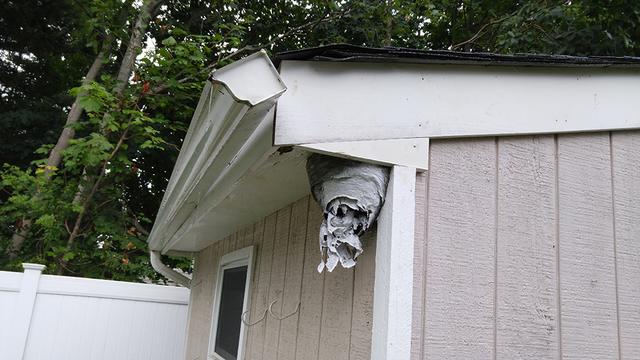Hornets in huge nest threaten Manahawkin residents - Bee & hornet control and removal in Manahawkin, NJ
Challenge
I was dispatched to a residence in a a senior housing development in Manasquan to remove a large hornets' nest from a bush on the homeowner’s property. The homeowner made the right decision to call Cowleys. There are many good do-it-yourself projects around the home. But removing a hornet’s nest is not one of them. These insects are aggressive and will attack anyone or anything that invades their space. Their aggressive territorial behavior makes baldfaced hornet removal especially challenging. Aggravating the colony can send hundreds of angry wasps right in your direction. One sting is painful; multiple stings are downright excruciating. And if you have a sensitivity to their venom, these stings can be potentially life-threatening. With this particular hornet’s nest, the neighbor had already ventured to close to the nest, and found out the hard way that hornets do not like to be bothered.
The baldfaced hornet is not a true hornet; rather, it is an aerial yellow jacket. This stinging insect is named a hornet because of its large size and aerial nests, that are built at least a few feet off the ground. This insect gets its name from its distinctive ivory-white markings on its face. They build nests in bushes, trees, and often, especially when we are called, on the outside of homes or other buildings. These stinging insects know how to build nests quickly. After a week a so, the nest could be the size of a softball, and soon thereafter, the size of a football.
Solution
I safely treated the nest with a chemical application. However, I purposely did not immediately remove it. I wanted to allow the foraging hornets away from the nest time to return and come into contact with the application. This small delay kills those those hornets that happened to be away from the nest when the chemical was applied, and I did not want these stragglers to rebuild a nest elsewhere on the property. Instead, with my application, I transformed the nest into a chemical trap, and I wanted to give it time to work. Of course, I can’t guarantee that every single member of the colony is killed. After all, a single hornet colony can grow to several hundred workers. However, the few that escape justice will soon be taken care of by nature. The entire colony, other than the newly fertilized potential queens that will overwinter, die around the time of the first hard frost. These new queens that emerge the following spring will build their own nests, but hopefully this time, on someone else’s property.
The homeowners were grateful that the nest was removed from their bush, and the problem was taken care of so quickly. Now, they could return to enjoying their retirement and their backyard without fear of painful stings. The neighbor who had the first-hand experience of feeling the pain of a sting was also happy that the nest was removed, although he would have preferred that Cowleys had come out there a day or two before his unpleasant hornet encounter. I can tell you from personal experience, that once you are stung by a hornet, it is a pain sensation that you’ll never forget. Although Cowleys technicians always wear protective gear when removing the nests of yellow jackets, hornets, and other stinging insects, these insects have an uncanny ability to find their way to your skin. And once they do, they’ll let you know in their own special way that they don’t appreciate having their nest disturbed.


